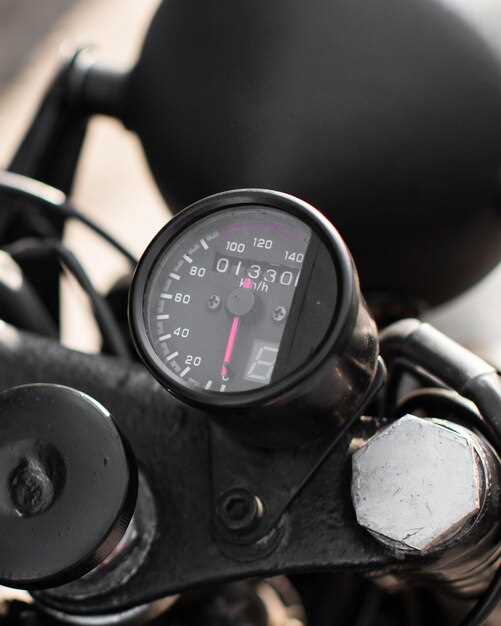
Every motorcycle enthusiast knows the thrill of acceleration: the rush of wind against your body and the sensation of gripping the throttle as you surge forward. However, achieving optimal acceleration often requires a meticulous approach to tuning. By understanding the fundamental components that influence performance, you can unlock your motorcycle’s true potential.
Acceleration is primarily affected by a combination of engine performance, weight distribution, and aerodynamics. One of the first steps in tuning your motorcycle involves a thorough evaluation of its engine and componentry. Upgrading components such as the exhaust system, air filter, and fuel mapping can yield significant improvements. Engine tuning not only enhances horsepower but also ensures that your bike responds more aggressively when you twist the throttle.
Another crucial aspect to consider is the weight of the motorcycle. A lighter bike accelerates faster, so examining ways to reduce weight–whether through component replacement or adjusting your riding gear–can offer substantial gains. Additionally, fine-tuning the suspension and tire pressure can contribute to a better grip and stability, which are essential for maximizing acceleration.
Lastly, paying attention to aerodynamic modifications can greatly enhance your motorcycle’s performance. Streamlined fairings, optimized riding posture, and proper bike setup reduce drag, allowing for smoother and faster acceleration. Throughout this article, we will delve deeper into these tuning strategies, providing you with actionable insights to transform your riding experience and achieve exhilarating acceleration on the open road.
Choosing the Right Performance Exhaust System
Selecting the ideal performance exhaust system is crucial for enhancing your motorcycle’s acceleration and overall performance. A well-chosen exhaust can significantly improve the engine’s breathing capability, increase horsepower, and provide a more aggressive sound profile that complements your riding style.
When choosing an exhaust system, consider the material. Options typically include stainless steel, titanium, and aluminized steel. Stainless steel is durable and rust-resistant but tends to be heavier. Titanium is lighter and offers excellent heat resistance but can be more expensive. Aluminized steel provides a cost-effective solution but may not offer the same longevity and performance as the other materials.
Next, examine the type of system: slip-on vs. full exhaust. A slip-on system is easier to install and usually less expensive while providing noticeable gains in performance and sound. However, a full exhaust system replaces both the header and the muffler, enabling more significant power improvements due to better flow dynamics but often requires more complex installation.
Also, pay attention to the design of the exhaust. Performance headers that taper or have a larger diameter can help to reduce back pressure, allowing exhaust gases to exit more freely, which can improve engine performance. Additionally, look for an exhaust with appropriate internal baffling to maintain optimal sound levels without excess noise.
Consider your specific riding conditions and goals. If you primarily ride in urban environments, a system designed for faster throttle response at lower RPMs might be beneficial. For track use, a system that emphasizes top-end power may be more appropriate.
Finally, check for compatibility with your motorcycle’s make and model. Some aftermarket options may require minor modifications to fit properly, while others may have specific tuning requirements to achieve optimal performance gains. It’s often worthwhile to consult with professionals or fellow enthusiasts to find the best fit for your needs.
Adjusting the Fuel-to-Air Mixture for Optimal Combustion
Adjusting the fuel-to-air mixture is crucial for achieving optimal combustion in your motorcycle engine. An ideal ratio ensures that the fuel burns efficiently, enhancing performance, improving acceleration, and minimizing emissions. Here’s how to adjust this ratio effectively:
-
Understanding the Stoichiometric Ratio:
The stoichiometric ratio for gasoline is approximately 14.7 parts air to 1 part fuel. This ratio facilitates complete combustion. Deviations can lead to either a rich mixture (too much fuel) or a lean mixture (too much air).
-
Checking the Current Mixture:
Before making adjustments, it’s essential to measure the current fuel-to-air mixture. You can do this by:
- Utilizing an air-fuel ratio gauge.
- Observing engine performance metrics.
- Checking spark plug condition for signs of rich or lean combustion.
-
Adjusting for Performance:
To fine-tune your motorcycle’s fuel-to-air mixture:
- Modify Jetting: For carbureted engines, changing the main jet size can help adjust the fuel flow.
- Use Adjustable Fuel Pressure Regulators: For fuel-injected models, altering fuel pressure can modify the fuel delivery.
- Reprogram ECU: In modern motorcycles, adjusting the ECU settings or installing a fuel management system can optimize the mixture.
-
Testing and Tuning:
After making adjustments, conduct performance tests:
- Accelerate to check responsiveness and power delivery.
- Observe engine temperature; excessive heat may signal a lean mixture.
- Inspect exhaust emissions; black smoke indicates richness, while a very lean mixture can lead to backfiring.
-
Regular Maintenance:
It is important to regularly check and adjust the fuel-to-air mixture due to factors like:
- Altitude changes affecting air density.
- Environmental conditions such as humidity.
- Modifications made to the engine or exhaust system.
By carefully adjusting the fuel-to-air mixture, you can significantly enhance your motorcycle’s acceleration and overall performance while ensuring efficient combustion and reducing harmful emissions.
Upgrading the ECU for Enhanced Throttle Response

Upgrading the Engine Control Unit (ECU) is one of the most effective modifications for improving throttle response on your motorcycle. The ECU controls various engine parameters, such as fuel injection, ignition timing, and throttle position, directly influencing performance and acceleration.
Custom Mapping: A primary benefit of an upgraded ECU is the ability to apply a custom mapping tailored to your motorcycle’s specific needs. By recalibrating the fuel maps and ignition timing, you can achieve a more responsive throttle and a smoother power delivery. This optimizes the engine’s performance characteristics, making it more reactive to your inputs.
Increased Rev Limiter: Many aftermarket ECUs allow for adjustments to the rev limiter. By raising the rev limit, you can extract more power from your engine, leading to enhanced acceleration. However, this requires careful tuning to avoid potential engine damage.
Improved Throttle Sensitivity: An upgraded ECU can enhance throttle sensitivity, allowing for quicker responses when you twist the throttle. This responsiveness is crucial for aggressive riding styles, as it enables better control during acceleration, especially in critical situations.
Advanced Features: Many modern ECUs come with advanced features such as traction control and anti-lock braking systems. While these features primarily focus on safety, they can also contribute to improved acceleration by maintaining traction during hard acceleration, preventing wheel spin, and allowing the rider to focus on maximizing throttle input.
Compatibility with Other Mods: Upgrading the ECU is often necessary when you make other performance modifications, such as installing a new exhaust system or high-performance air filter. The ECU must be recalibrated to accommodate these changes, ensuring that the engine operates efficiently and effectively.
In conclusion, upgrading the ECU is a crucial step for any motorcycle enthusiast aiming to enhance throttle response and overall acceleration. With custom mapping, improved sensitivity, and compatibility with other performance modifications, this upgrade yields significant benefits in riding performance.
Selecting Appropriate Gearing Ratios for Quick Acceleration
Choosing the right gearing ratios is essential for enhancing your motorcycle’s acceleration performance. The gearing ratio defines the relationship between the engine’s output and the rear wheel’s speed. A lower gearing ratio typically results in quicker acceleration, allowing the motorcycle to reach higher RPMs faster. This can be particularly beneficial for racing or off-the-line performance.
When selecting gearing ratios, consider your riding style and intended use. For aggressive street riding or track racing, lower ratios such as 14/40 or 15/44 may be preferred, as they offer rapid acceleration at the expense of top speed. Conversely, for long-distance cruising or sport-touring, higher ratios such as 16/42 focus more on fuel efficiency and stability at elevated speeds, sacrificing some of the initial acceleration.
It’s also crucial to account for the motorcycle’s engine characteristics. A high-revving engine may benefit from lower gearing, as it can reach optimal power earlier. In contrast, a torque-heavy engine might require slightly higher gearing to prevent excessive RPMs while still providing adequate acceleration.
Furthermore, adjustments to tire size can impact effective gearing ratios. Larger tires effectively increase the gearing ratio, leading to slower acceleration unless counterbalanced by lower sprocket sizes. Always ensure that your gear selection harmonizes with your motorcycle’s overall specifications to achieve a balanced performance.
Lastly, using a professional gearing calculator can provide insights into how different sprocket combinations affect acceleration and top speed. Experimenting with various ratios can yield personalized setups tailored to your specific preferences, enhancing your riding experience while maintaining mechanical integrity.
Installing Lighter Components to Reduce Weight
Reducing the weight of your motorcycle is a crucial step in enhancing its acceleration. Lighter components not only improve thrust and acceleration but also contribute to better handling and overall performance. Identifying and replacing heavier parts with lightweight alternatives can significantly influence your motorcycle’s agility and responsiveness.
Common components to consider upgrading include the following:
| Component | Stock Material | Lightweight Alternative | Weight Savings |
|---|---|---|---|
| Wheels | Cast Aluminum | Forged Aluminum / Carbon Fiber | 5-10 lbs |
| Exhaust System | Stainless Steel | Titanium | 3-7 lbs |
| Subframe | Steel | Aluminum | 3-8 lbs |
| Footpegs | Aluminum | Magnesium / Carbon Fiber | 0.5-2 lbs |
| Bodywork | Plastic / Fiberglass | Carbon Fiber | 2-5 lbs |
When opting for lighter components, ensure they possess adequate strength and durability to handle the rigors of riding. Additionally, weigh the cost versus benefits of each modification, as some lightweight parts can be quite pricey. Prioritize components that will yield the most significant weight reduction, impacting not only acceleration but also the motorcycle’s overall dynamics.
Lastly, while reducing weight enhances performance, maintaining a balanced motorcycle is essential. Ensure that the distribution of weight remains optimal after each upgrade for improved stability during acceleration and cornering.
Regular Maintenance Checks to Ensure Peak Performance
To achieve optimal acceleration and overall performance from your motorcycle, regular maintenance is essential. Here are the key areas to focus on during your maintenance checks:
- Engine Oil: Regularly check and change the engine oil as per the manufacturer’s recommendations. Clean oil lubricates internal components efficiently, reducing friction and enhancing performance.
- Air Filter: Inspect the air filter frequently. A clean air filter allows for optimal airflow to the engine, improving combustion efficiency and acceleration. Replace it when it’s dirty or clogged.
- Fuel System: Monitor the fuel system for any potential blockages or leaks. Use quality fuel and consider adding a fuel cleaner periodically to avoid deposits in the injectors or carburetors.
- Chain and Sprockets: Keep the chain lubricated and properly adjusted. A well-maintained chain reduces power loss during transmission and contributes to smoother acceleration.
- Tires: Regularly check tire pressure and tread wear. Properly inflated tires improve grip and handling, contributing to better acceleration. Replace tires that show signs of excessive wear.
- Brakes: Inspect brake pads and fluid levels frequently. While brakes are crucial for safety, their efficiency directly impacts your bike’s acceleration when maneuvering or stopping.
- Battery: Ensure the battery terminals are clean and connections are tight. A fully charged and functioning battery is essential for reliable starts and optimal performance.
- Electrical System: Regularly check lights, signals, and other electronic components to ensure they function correctly. Malfunctions can affect visibility and handling, ultimately impacting acceleration.
- Suspension: Inspect and adjust the suspension settings according to your riding style and weight. Proper suspension tuning helps maintain stability and enhances ride quality, which aids in acceleration.
Following these maintenance practices will not only boost your motorcycle’s acceleration but will also prolong its lifespan and ensure a safer riding experience. Consistency is key to maintaining peak performance.

